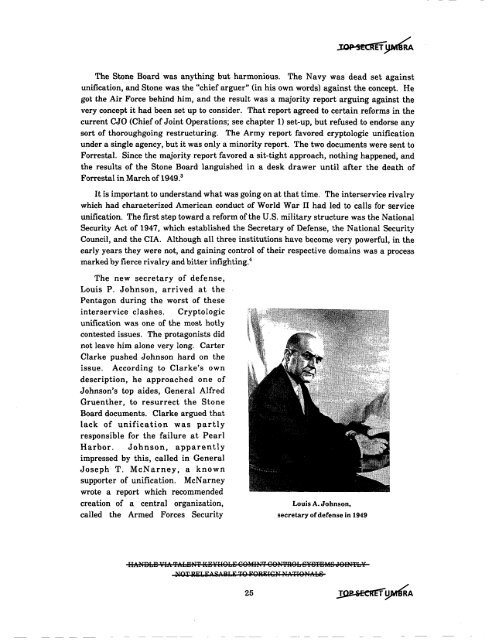American Cryptology during the Cold War - The Black Vault
American Cryptology during the Cold War - The Black Vault
American Cryptology during the Cold War - The Black Vault
You also want an ePaper? Increase the reach of your titles
YUMPU automatically turns print PDFs into web optimized ePapers that Google loves.
<strong>The</strong> Stone Board was anything but harmonious. <strong>The</strong> Navy was dead set against<br />
unification, and Stone was <strong>the</strong> "chief arguer" (in his own words) against <strong>the</strong> concept. He<br />
got <strong>the</strong> Air Force behind him, and <strong>the</strong> result was a majority report arguing against <strong>the</strong><br />
very concept it had been set up to consider. That report agreed to certain reforms in <strong>the</strong><br />
current CJO (Chief of Joint Operations; see chapter 1) set-up, but refused to endorse any<br />
sort of thoroughgoing restructuring. <strong>The</strong> Army report favored cryptologic unification<br />
under a single agency, but it was only a minority report. <strong>The</strong> two documents were sent to<br />
Forrestal. Since <strong>the</strong> majority report favored a sit-tight approach, nothing happened, and<br />
<strong>the</strong> results of <strong>the</strong> Stone Board languished in a desk drawer until after <strong>the</strong> death of<br />
Forrestal in March of1949. 3<br />
It is important to understand what was going on at that time. <strong>The</strong> interservice rivalry<br />
which had characterized <strong>American</strong> conduct of WorId <strong>War</strong> II had led to calls for service<br />
unification. <strong>The</strong> first step toward a reform of<strong>the</strong> U.S. military structure was <strong>the</strong> National<br />
Security Act of 1947, which established <strong>the</strong> Secretary of Defense, <strong>the</strong> National Security<br />
Council, and <strong>the</strong> CIA. Although all three institutions have become very powerful, in <strong>the</strong><br />
early years <strong>the</strong>y were not, and gaining control of <strong>the</strong>ir respective domains was a process<br />
marked by fierce rivalry and bitter infighting. 4<br />
<strong>The</strong> new secretary of defense,<br />
Louis P. Johnson, arrived at <strong>the</strong><br />
Pentagon <strong>during</strong> <strong>the</strong> worst of <strong>the</strong>se<br />
interservice clashes. Cryptologic<br />
unification was one of <strong>the</strong> most hotly<br />
contested issues. <strong>The</strong> protagonists did<br />
not leave him alone very long. Carter<br />
Clarke pushed Johnson hard on <strong>the</strong><br />
issue. According to Clarke's own<br />
description, he approached one of<br />
Johnson's top aides, General Alfred<br />
Gruen<strong>the</strong>r, to resurrect <strong>the</strong> Stone<br />
Board documents. Clarke argued that<br />
lack of unification was partly<br />
responsible for <strong>the</strong> failure at Pearl<br />
Harbor. Johnson, apparently<br />
impressed by this, called in General<br />
Joseph T. McNarney, a known<br />
supporter of unification. McNarney<br />
wrote a report which recommended<br />
creation of a central organization,<br />
called <strong>the</strong> Armed Forces Security<br />
Louis A. Johnson,<br />
secretary ofdefense in 1949<br />
I1ld'fBl=Jll ';1>'. 'i'Abl!lJ'l"'i' KI!l¥IIQbE GQMIN'i' GQJ'l"'i'RQb SYS'i'EfIIS oJ8IN'i'bY<br />
WTRiU A ~ A In.i TQ VQREIQW J'fA'i'IQJ'W.bS<br />
25
















